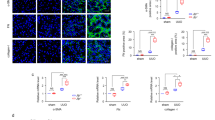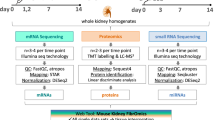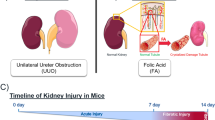Abstract
Kidney fibrosis is a common process that leads to the progression of various types of kidney disease. We used an integrated computational and experimental systems biology approach to identify protein kinases that regulate gene expression changes in the kidneys of human immunodeficiency virus (HIV) transgenic mice (Tg26 mice), which have both tubulointerstitial fibrosis and glomerulosclerosis. We identified homeo-domain interacting protein kinase 2 (HIPK2) as a key regulator of kidney fibrosis. HIPK2 was upregulated in the kidneys of Tg26 mice and in those of patients with various kidney diseases. HIV infection increased the protein concentrations of HIPK2 by promoting oxidative stress, which inhibited the seven in absentia homolog 1 (SIAH1)-mediated proteasomal degradation of HIPK2. HIPK2 induced apoptosis and the expression of epithelial-to-mesenchymal transition markers in kidney epithelial cells by activating the p53, transforming growth factor β (TGF-β)–SMAD family member 3 (Smad3) and Wnt-Notch pathways. Knockout of HIPK2 improved renal function and attenuated proteinuria and kidney fibrosis in Tg26 mice, as well as in other murine models of kidney fibrosis. We therefore conclude that HIPK2 is a potential target for anti-fibrosis therapy.
This is a preview of subscription content, access via your institution
Access options
Subscribe to this journal
Receive 12 print issues and online access
$209.00 per year
only $17.42 per issue
Buy this article
- Purchase on Springer Link
- Instant access to full article PDF
Prices may be subject to local taxes which are calculated during checkout






Similar content being viewed by others
Change history
20 July 2021
A Correction to this paper has been published: https://doi.org/10.1038/s41591-021-01427-1
References
Wyatt, C.M. & Klotman, P.E. HIV-associated nephropathy in the era of antiretroviral therapy. Am. J. Med. 120, 488–492 (2007).
Leventhal, J.S. & Ross, M.J. Pathogenesis of HIV-associated nephropathy. Semin. Nephrol. 28, 523–534 (2008).
Bruggeman, L.A. et al. Renal epithelium is a previously unrecognized site of HIV-1 infection. J. Am. Soc. Nephrol. 11, 2079–2087 (2000).
Kopp, J.B. et al. Progressive glomerulosclerosis and enhanced renal accumulation of basement membrane components in mice transgenic for human immunodeficiency virus type 1 genes. Proc. Natl. Acad. Sci. USA 89, 1577–1581 (1992).
Dickie, P. et al. HIV-associated nephropathy in transgenic mice expressing HIV-1 genes. Virology 185, 109–119 (1991).
Calzado, M.A., Renner, F., Roscic, A. & Schmitz, M.L. HIPK2: a versatile switchboard regulating the transcription machinery and cell death. Cell Cycle 6, 139–143 (2007).
Isono, K. et al. Overlapping roles for homeodomain-interacting protein kinases hipk1 and hipk2 in the mediation of cell growth in response to morphogenetic and genotoxic signals. Mol. Cell. Biol. 26, 2758–2771 (2006).
D'Orazi, G. et al. Homeodomain-interacting protein kinase-2 phosphorylates p53 at Ser 46 and mediates apoptosis. Nat. Cell Biol. 4, 11–19 (2002).
Lee, W., Swarup, S., Chen, J., Ishitani, T. & Verheyen, E.M. Homeodomain-interacting protein kinases (Hipks) promote Wnt/Wg signaling through stabilization of β-catenin/Arm and stimulation of target gene expression. Development 136, 241–251 (2009).
Lee, W., Andrews, B.C., Faust, M., Walldorf, U. & Verheyen, E.M. Hipk is an essential protein that promotes Notch signal transduction in the Drosophila eye by inhibition of the global co-repressor Groucho. Dev. Biol. 325, 263–272 (2009).
Zhang, J. et al. Essential function of HIPK2 in TGFβ-dependent survival of midbrain dopamine neurons. Nat. Neurosci. 10, 77–86 (2007).
Hofmann, T.G., Stollberg, N., Schmitz, M.L. & Will, H. HIPK2 regulates transforming growth factor-β–induced c-Jun NH(2)-terminal kinase activation and apoptosis in human hepatoma cells. Cancer Res. 63, 8271–8277 (2003).
Seth, R., Yang, C., Kaushal, V., Shah, S.V. & Kaushal, G.P. p53-dependent caspase-2 activation in mitochondrial release of apoptosis-inducing factor and its role in renal tubular epithelial cell injury. J. Biol. Chem. 280, 31230–31239 (2005).
Yoo, J. et al. Transforming growth factor-β–induced apoptosis is mediated by Smad-dependent expression of GADD45b through p38 activation. J. Biol. Chem. 278, 43001–43007 (2003).
Inazaki, K. et al. Smad3 deficiency attenuates renal fibrosis, inflammation,and apoptosis after unilateral ureteral obstruction. Kidney Int. 66, 597–604 (2004).
Zeisberg, M. et al. BMP-7 counteracts TGF-β1–induced epithelial-to-mesenchymal transition and reverses chronic renal injury. Nat. Med. 9, 964–968 (2003).
Vincent, T. et al. A SNAIL1-SMAD3/4 transcriptional repressor complex promotes TGF-β mediated epithelial-mesenchymal transition. Nat. Cell Biol. 11, 943–950 (2009).
Zavadil, J., Cermak, L., Soto-Nieves, N. & Bottinger, E.P. Integration of TGF-β/Smad and Jagged1/Notch signalling in epithelial-to-mesenchymal transition. EMBO J. 23, 1155–1165 (2004).
Zavadil, J. & Bottinger, E.P. TGF-β and epithelial-to-mesenchymal transitions. Oncogene 24, 5764–5774 (2005).
Matys, V. et al. TRANSFAC: transcriptional regulation, from patterns to profiles. Nucleic Acids Res. 31, 374–378 (2003).
Lachmann, A. et al. ChEA: transcription factor regulation inferred from integrating genome-wide ChIP-X experiments. Bioinformatics 26, 2438–2444 (2010).
Berger, S.I., Posner, J.M. & Ma'ayan, A. Genes2Networks: connecting lists of gene symbols using mammalian protein interactions databases. BMC Bioinformatics 8, 372 (2007).
Lachmann, A. & Ma'ayan, A. KEA: kinase enrichment analysis. Bioinformatics 25, 684–686 (2009).
He, J.C. et al. Nef stimulates proliferation of glomerular podocytes through activation of Src-dependent Stat3 and MAPK1,2 pathways. J. Clin. Invest. 114, 643–651 (2004).
Winter, M. et al. Control of HIPK2 stability by ubiquitin ligase Siah-1 and checkpoint kinases ATM and ATR. Nat. Cell Biol. 10, 812–824 (2008).
Husain, M. et al. Inhibition of p66ShcA longevity gene rescues podocytes from HIV-1–induced oxidative stress and apoptosis. J. Biol. Chem. 284, 16648–16658 (2009).
Rosenstiel, P.E. et al. HIV-1 Vpr activates the DNA damage response in renal tubule epithelial cells. AIDS 23, 2054–2056 (2009).
Hikasa, H. & Sokol, S.Y. Phosphorylation of TCF proteins by homeodomain-interacting protein kinase 2. J. Biol. Chem. 286, 12093–12100 (2011).
Boutet, A. et al. Snail activation disrupts tissue homeostasis and induces fibrosis in the adult kidney. EMBO J. 25, 5603–5613 (2006).
Mizui, M. et al. Transcription factor Ets-1 is essential for mesangial matrix remodeling. Kidney Int. 70, 298–305 (2006).
Pico, A.R. et al. WikiPathways: pathway editing for the people. PLoS Biol. 6, e184 (2008).
Kriz, W., Kaissling, B. & Le Hir, M. Epithelial-mesenchymal transition (EMT) in kidney fibrosis: fact or fantasy? J. Clin. Invest. 121, 468–474 (2011).
Zhang, Q., Yoshimatsu, Y., Hildebrand, J., Frisch, S.M. & Goodman, R.H. Homeodomain interacting protein kinase 2 promotes apoptosis by downregulating the transcriptional corepressor CtBP. Cell 115, 177–186 (2003).
Wei, G. et al. HIPK2 represses β-catenin–mediated transcription, epidermal stem cell expansion, and skin tumorigenesis. Proc. Natl. Acad. Sci. USA 104, 13040–13045 (2007).
Hertig, A. [Epithelial-mesenchymal transition of the renal graft]. Nephrol. Ther. 4 (suppl. 1), S25–S28 (2008).
Long, D.A. et al. Angiopoietin-1 therapy enhances fibrosis and inflammation following folic acid-induced acute renal injury. Kidney Int. 74, 300–309 (2008).
Doi, K. et al. Attenuation of folic acid-induced renal inflammatory injury in platelet-activating factor receptor–deficient mice. Am. J. Pathol. 168, 1413–1424 (2006).
Bielesz, B. et al. Epithelial Notch signaling regulates interstitial fibrosis development in the kidneys of mice and humans. J. Clin. Invest. 120, 4040–4054 (2010).
Snyder, A. et al. HIV-1 viral protein r induces ERK and caspase-8–dependent apoptosis in renal tubular epithelial cells. AIDS 24, 1107–1119 (2010).
Yadav, A. et al. HIVAN phenotype: consequence of epithelial mesenchymal transdifferentiation. Am. J. Physiol. Renal Physiol. 298, F734–F744 (2009).
Ross, M.J. et al. Role of ubiquitin-like protein FAT10 in epithelial apoptosis in renal disease. J. Am. Soc. Nephrol. 17, 996–1004 (2006).
Docherty, N.G., O'Sullivan, O.E., Healy, D.A., Fitzpatrick, J.M. & Watson, R.W. Evidence that inhibition of tubular cell apoptosis protects against renal damage and development of fibrosis following ureteric obstruction. Am. J. Physiol. Renal Physiol. 290, F4–F13 (2006).
Zeisberg, M. & Kalluri, R. The role of epithelial-to-mesenchymal transition in renal fibrosis. J. Mol. Med. 82, 175–181 (2004).
Quaggin, S.E. & Kapus, A. Scar wars: mapping the fate of epithelial-mesenchymal-myofibroblast transition. Kidney Int. 80, 41–50 (2011).
Hertig, A., Flier, S.N. & Kalluri, R. Contribution of epithelial plasticity to renal transplantation-associated fibrosis. Transplant. Proc. 42, S7–S12 (2010).
Mainra, R., Gallo, K. & Moist, L. Effect of N-acetylcysteine on renal function in patients with chronic kidney disease. Nephrology (Carlton) 12, 510–513 (2007).
Di Stefano, V., Blandino, G., Sacchi, A., Soddu, S. & D'Orazi, G. HIPK2 neutralizes MDM2 inhibition rescuing p53 transcriptional activity and apoptotic function. Oncogene 23, 5185–5192 (2004).
Rinaldo, C., Prodosmo, A., Siepi, F. & Soddu, S. HIPK2: a multitalented partner for transcription factors in DNA damage response and development. Biochem. Cell Biol. 85, 411–418 (2007).
Rosenstiel, P.E. et al. HIV-1 Vpr inhibits cytokinesis in human proximal tubule cells. Kidney Int. 74, 1049–1058 (2008).
He, J.C. et al. Nef stimulates proliferation of glomerular podocytes through activation of Src-dependent Stat3 and MAPK1,2 pathways. J. Clin. Invest. 114, 643–651 (2004).
Ross, M.J. et al. Role of ubiquitin-like protein FAT10 in epithelial apoptosis in renal disease. J. Am. Soc. Nephrol. 17, 996–1004 (2006).
Zhang, Q., Yoshimatsu, Y., Hildebrand, J., Frisch, S.M. & Goodman, R.H. Homeodomain interacting protein kinase 2 promotes apoptosis by downregulating the transcriptional corepressor CtBP. Cell 115, 177–186 (2003).
Winter, M. et al. Control of HIPK2 stability by ubiquitin ligase Siah-1 and checkpoint kinases ATM and ATR. Nat. Cell Biol. 10, 812–824 (2008).
Ivanovski, O. et al. The antioxidant N-acetylcysteine prevents accelerated atherosclerosis in uremic apolipoprotein E knockout mice. Kidney Int. 67, |2288–2294 (2005).
D'Agati, V. Pathologic classification of focal segmental glomerulosclerosis. Semin. Nephrol. 23, 117–134 (2003).
He, W. et al. Wnt/beta-catenin signaling promotes renal interstitial fibrosis. J. Am. Soc. Nephrol. 20, 765–776 (2009).
Junqueira, L.C., Bignolas, G. & Brentani, R.R. Picrosirius staining plus polarization microscopy, a specific method for collagen detection in tissue sections. Histochem. J. 11, 447–455 (1979).
Yang, J., Dai, C. & Liu, Y. Hepatocyte growth factor gene therapy and angiotensin II blockade synergistically attenuate renal interstitial fibrosis in mice. J. Am. Soc. Nephrol. 13, 2464–2477 (2002).
Takemoto, M. et al. A new method for large scale isolation of kidney glomeruli from mice. Am. J. Pathol. 161, 799–805 (2002).
Ratnam, K.K. et al. Role of the retinoic acid receptor-alpha in HIV-associated nephropathy. Kidney Int. 79, 624–634 (2011).
Acknowledgements
The authors acknowledge and thank G.L. Gusella (Mount Sinai School of Medicine, New York) for providing the lentiviral construct, E. Huang (University of California San Francisco) for providing the HIPK2 KO mice, P. Mundel (Massachusetts General Hospital, Boston) for synaptopodin antibody and conditionally immortalized murine podocyte cell line, L. Holzman (University of Pennsylvania, Philadelphia) for nephrin antibody and R.H. Goodman (Oregon Health and Science University, Portland) for WT-HIPK2 and KD-HIPK2 constructs. We also thank R. Iyengar and P. Klotman for critical suggestions on experimental design and for other valuable contributions. J.C.H. is supported by US National Institutes of Health (NIH) grant 1R01DK078897 and a Veterans Affairs Merit Award; J.C.H. and A.M. are supported by NIH 1R01DK088541, NIH P01-DK-56492 and NIH 1RC4DK090860; A.M. is supported by NIH RC2OD006536 and 5P50GM071558; P.Y.C. is supported by NIH 5K08DK082760. N.C. is supported by Chinese 973 fund 2012CB517601.
Author information
Authors and Affiliations
Contributions
J.C.H., A.M., P.Y.C., Y.J., N.C. and K.R. designed the research project; Y.J., K.R., Y.F., Y.Z., M.J.R., H.X. and P.Y.C. performed the experiments; P.Y.C. and Y.D. prepared lentiviral constructs for HIPK2; V.D. analyzed the pathologic findings; A.M., E.Y.C. and A.R.M. performed bioinformatics and systems biology analyses; J.C.H., P.Y.C. and A.M. wrote the manuscript, and all authors contributed to the preparation of the manuscript.
Corresponding authors
Ethics declarations
Competing interests
The authors declare no competing financial interests.
Supplementary information
Supplementary Text and Figures
Supplementary Figures 1–6, Supplementary Tables 1–6 and Supplementary Methods (PDF 4095 kb)
Supplementary Data
Summary of ChEA, TRANSFAC, Genes2Network and KEA for identification of key signaling pathways activated in Tg26 kidney (XLSX 134 kb)
Rights and permissions
About this article
Cite this article
Jin, Y., Ratnam, K., Chuang, P. et al. A systems approach identifies HIPK2 as a key regulator of kidney fibrosis. Nat Med 18, 580–588 (2012). https://doi.org/10.1038/nm.2685
Received:
Accepted:
Published:
Issue Date:
DOI: https://doi.org/10.1038/nm.2685
This article is cited by
-
The occurrence and development mechanisms of esophageal stricture: state of the art review
Journal of Translational Medicine (2024)
-
Emerging role of tumor suppressor p53 in acute and chronic kidney diseases
Cellular and Molecular Life Sciences (2022)
-
Impact of genetic variant of HIPK2 on the risk of severe radiation pneumonitis in lung cancer patients treated with radiation therapy
Radiation Oncology (2020)
-
Crosstalk between NRF2 and HIPK2 shapes cytoprotective responses
Oncogene (2017)
-
Inhibition of the processing of miR-25 by HIPK2-Phosphorylated-MeCP2 induces NOX4 in early diabetic nephropathy
Scientific Reports (2016)



